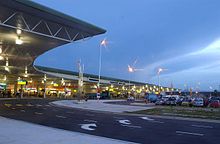Description
In some cases, the designs of a low-cost carrier terminal mimic old designs of an airport terminal, such as the former airport of Hong Kong, Kai Tak Airport. With a stripped-down airport terminal, airports can reduce daily operating costs significantly, thereby passing along the savings to budget airlines and ultimately their passengers. It specifically entails cost reductions from normal airports in terms of:
- Physical building:
- forgoing expensive architectural design for simple boxy warehouse-like design.
- low ceilings.
- foregoing steel and glass structures to reduce air conditioning overhead cost.[2]
- Amenities:
- may have less choice in terms of restaurants and duty-free shops.
- decoration may be mostly airline ads.
- Support structures:
- long corridors, moving walkways, and jet bridges often replaced by transport with airport buses and boarding with airstairs. (This also allows quicker plane turnaround time,[3] which may lower landing fees, and increase aircraft utilization).
- Baggage handling is much simplified, e.g. some LCCTs lack baggage carousels.
However these terminals may also have modern facilities such as free Wi-Fi, and be comfortably air conditioned. A German study (Swanson 2007) of costs showed that at Malaysia's KLIA and Changi LCCTs, airlines were charged roughly 2/3 to 3/4 the total cost of landing at the main terminal; for budget-sensitive carriers, any savings advantage can be critical.[4]
Klia2 billed as the world's largest purpose-built terminal dedicated to low-cost carriers, is designed to cater for 45 million passengers a year with future capacity expansion capability. Built at a cost of US$1.3 billion, klia2 started commercial operations on May 2, 2014, at the Kuala Lumpur International Airport in Malaysia.

